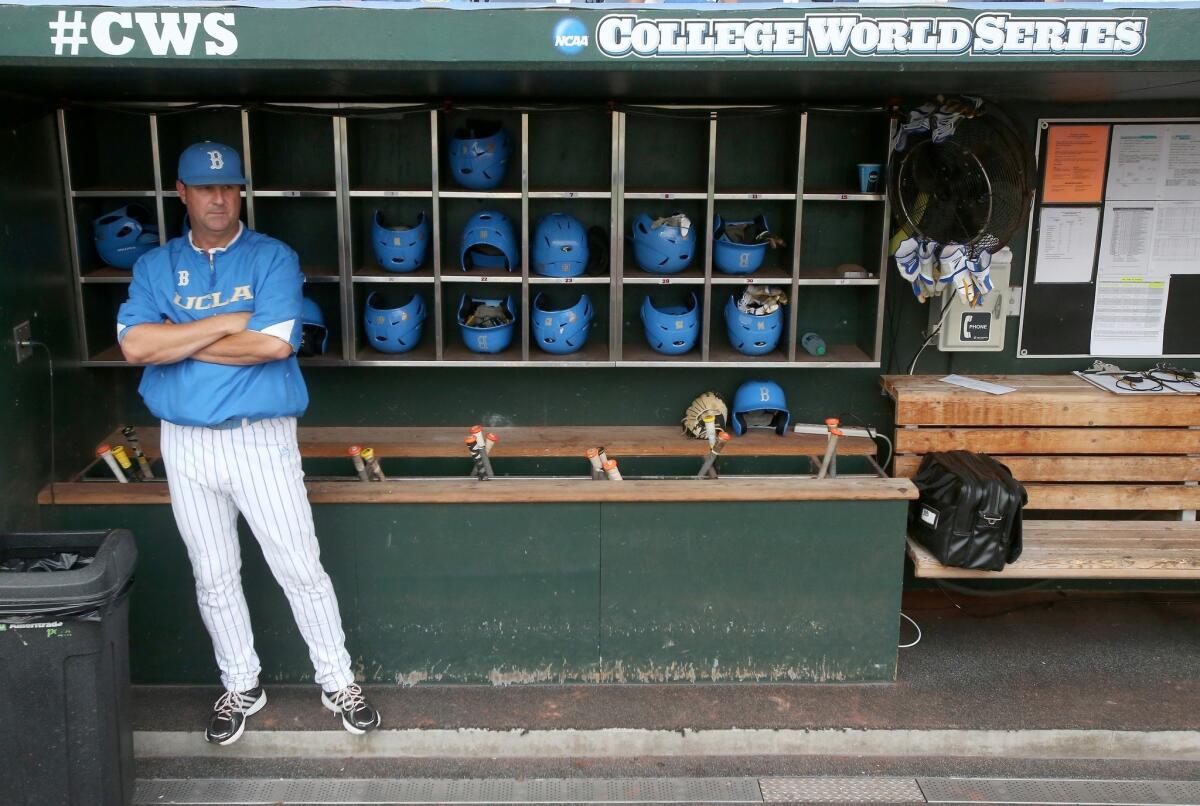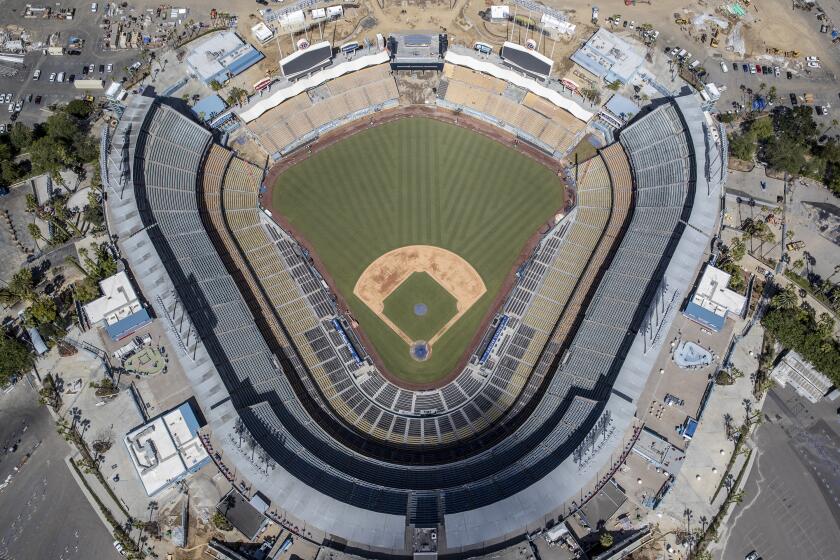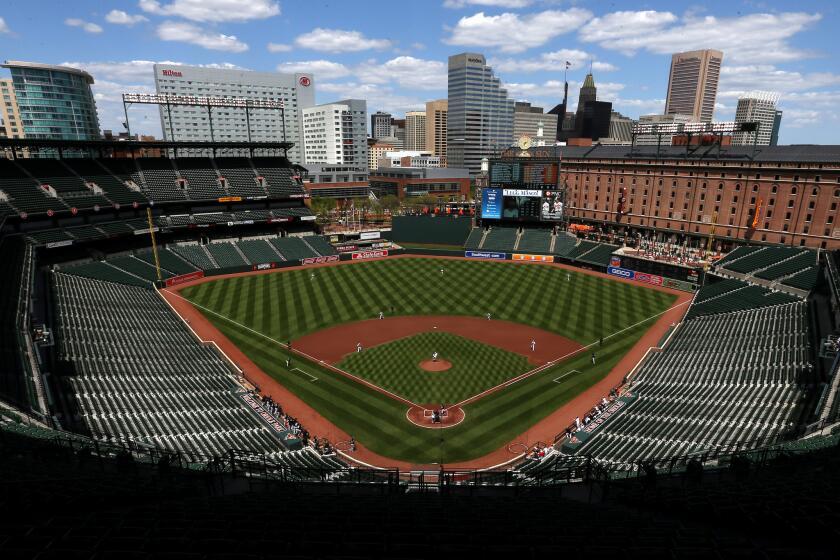Returning to college may be the only viable option for undrafted MLB prospects
- Share via
Nick Frasso would rather not think about the worst-case scenario.
The Loyola Marymount pitcher, after all, is a top-100 MLB draft prospect according to MLB Pipeline, a predicted top-five-round pick in a year in which that distinction has never been more important.
“Hopefully, I do end up going” in the top five rounds, he said. “It’s something I believe I can do.”
But then Frasso paused, took a breath and contemplated the other outcome MLB’s massively shortened five-round draft this summer had created.
“If not,” he continued, “I can go back to school for another year, graduate, and [re-enter the draft] next year. But hopefully, I’m in that top five.”
Such concern is pervasive among top prospects amid the coronavirus crisis. Nearly two months after the college baseball season was canceled, drastic changes to this summer’s MLB draft were confirmed last week. For most players, the news brought anything but relief.
Major League Baseball’s proposed safety protocols to play a season during the COVID-19 pandemic include plenty of do’s (testing) and dont’s (high-fives, hugs).
The 2020 draft will last five rounds instead of the customary 40, for a total of 160 selections including compensation picks. Those picked will be able to sign contracts with signing bonus values that will equal last year’s class, though all but $100,000 per player will be deferred to 2021 and 2020.
Meanwhile, those who don’t hear their name called will face a choice: Sign for a maximum of $20,000, an uber-discounted rate, or wait to reenter a future draft when circumstances in the sport have returned to normal.
It seems that, by capping signing bonuses at such a measly amount, MLB is signaling to undrafted players that they should return to school for at least a year. Minor leagues aren’t expected to resume until 2021, so even if a player signs, he’ll likely have nowhere to play this summer.
“It’s not a great thing for all those young men fighting most of their lives to get a chance to be drafted this particular year,” USC coach Jason Gill said. “They’ve been driving and working so hard for a particular year. It’s almost like an Olympian.”
Except instead of putting gold medals on the line, MLB’s changes put entire career paths in doubt.
“I know guys who were pretty much set on getting drafted,” Frasso said. “Now, nothing’s guaranteed.”
That’s true of every prospect who has been planning to turn pro this summer, whether it’s Arizona State slugger Spencer Torkelson, expected to be among the top three picks overall after hitting 54 home runs in his two-plus college seasons, or the several hundred prospects who have been pegged as middle-round draft picks.

“I have no control over the draft,” Torkelson said. “Just preparing for anything, getting ready for anything. When things get settled, I’ll be ready.”
But it’s the middle group, college and high school prospects who will miss the five-round cut, who face the most frustrating scenario. In normal years, players in the sixth- to 10th-round range, and even some picked later, are paid signing bonuses well in excess of $100,000, money they live off of during their low-earning minor league years. But now, they might have no choice but to wait and hope that better financial conditions return in future drafts.
“It’s going to affect pro baseball and college baseball in a ton of ways,” said Trenton Denholm, a UC Irvine pitcher ranked as the No. 129-rated draft prospect by MLB Pipeline. “It sucks for a lot of guys. I got teammates and I’m sure there are guys at basically every school who were planning on getting drafted that might end up going back to school.”
UCLA baseball coach John Savage is already planning for potential ripple effects.
Had this year’s draft been the normal 40 rounds, Savage figured as many as seven of his draft-eligible Bruins (at four-year universities, only seniors, juniors and 21-year-old sophomores can enter the draft) would be selected. In a five-round draft, however, he doubts more than three — outfielder Garrett Mitchell and pitchers Holden Powell and Zach Pettway — are serious contenders to be picked.
“I feel for them,” Savage said. “Everybody that’s been in professional baseball has always had the luxury of 40 rounds. Now this is the first generation of players looking at five. Who would ever think the MLB draft is going to have less rounds than the NFL draft?”
Mitchell is considered a top-10 overall pick, and Powell is projected as a fourth- or fifth-round pick. Pettway, on the other hand, is being projected as “anywhere from a fourth-round to a 10th-round pick,” Savage said. “So the news of five rounds drastically changes his odds. His odds of coming back [to school] look much better now than they did.”
Undrafted high school prospects could face an equally unsatisfying choice. Those who attend a four-year school would be, in most cases, ineligible for the draft until after their junior year. Going to a junior college would keep a player eligible for the draft next season but would come at the cost of an NCAA scholarship.
“There’s no reference point here, nothing to base this experience off of,” said Jared Halpert, coach of a Studio City Harvard-Westlake High program that includes two projected early-round picks in outfielder Pete Crow-Armstrong and shortstop Drew Bowser.
MLB is telling players their prorated salaries would contribute to an average loss of $640,000 for each game over an 82-game season in empty ballparks.
“Every individual and case is going to be different. There might be some kids that otherwise would say, ‘It’s the first round or it’s nothing,’ where maybe that’s not the case anymore, and obviously vice versa … because of the complete unknown of the situation, what college baseball is going to look like, what professional baseball is going to look like.”
It will create a talent logjam that could be felt for years. Even though the 2021 draft will reportedly include at least 20 rounds, competition for spots will be tight among a de facto double draft class, putting anyone not picked through another year of potentially crippling uncertainty.
But with MLB’s 2020 draft rules leaving few other realistic options, that winding road looks like players’ only way forward.
“I don’t think it’s going to be a heavy free agency [this summer], in terms of high school kids or juniors in college or draft-eligible sophomores,” said Gill, whose best prospect at USC, Jamal O’Guinn, is not guaranteed to be picked. “MLB knows that. But I think it’s just a sign of the times, right? They’re stuck between a rock and a hard place, just like we are. It’s not really anybody’s fault.”
More to Read
Go beyond the scoreboard
Get the latest on L.A.'s teams in the daily Sports Report newsletter.
You may occasionally receive promotional content from the Los Angeles Times.













